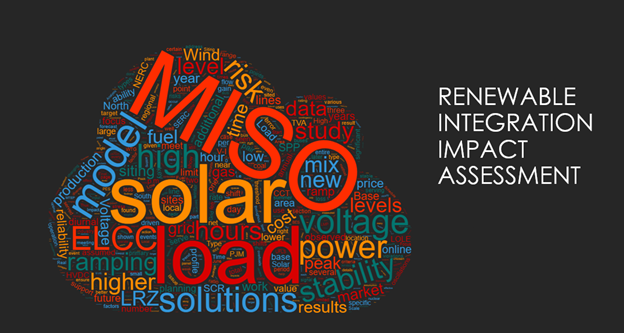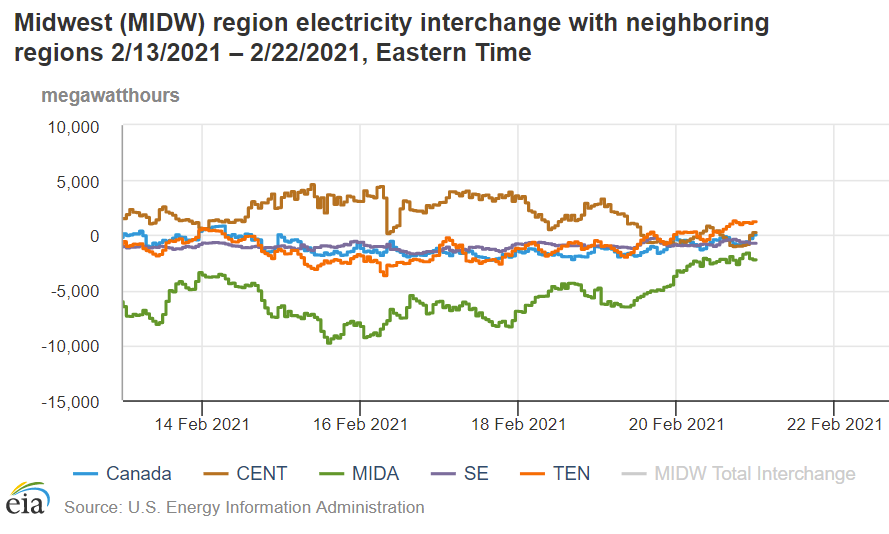
This afternoon, @MISO_energy is hosting its final workshop on the Renewable Integration Impact Assessment report. Didn’t read the 217pg report? I’ve created this thread to prep you for the 1pm CT call. (here's the report: cdn.misoenergy.org/RIIA%20Summary…, and the report as a word cloud:) 

RIIA began in 2017 as a study to find “inflection points” for renewable penetration in MISO. These are the key questions RIIA set out to tackle: When does renewable integration get hard, and how do we fix it? 

If there’s one key takeaway from RIIA, it’s this pull quote from the report: “Through coordinated action with MISO stakeholders, RIIA concludes that renewable penetration beyond 50% can be achieved.” That’s great news, and a big deal. 

More of my favorite takeaways:
“Transmission Solutions Enable More Power Interchange, Using Diverse, Variable Resources from Across the Footprint”
“storage and transmission may mutually benefit each other”
“MISO Futures demonstrate the 30% milestone could occur as soon as 2026.”
“Transmission Solutions Enable More Power Interchange, Using Diverse, Variable Resources from Across the Footprint”
“storage and transmission may mutually benefit each other”
“MISO Futures demonstrate the 30% milestone could occur as soon as 2026.”
MISO’s work on RIIA needs to expand and continue to improve as we gain better technologies, methodologies, and understanding. In '17, we didn’t include electric vehicles, hybrids or batteries in RIIA. We now know those technologies are critical to the future.
Initially, RIIA looked at a 75/25 wind/solar split, heavily focused on MISO North where MISO North adds 95GW of renewables (mostly wind), but only 15 GW of solar in MISO South. Later, MISO also conducted a 50/50 solar/wind sensitivity. Things change, even in 4 yrs. 

(Aside: There’s already 12 GW of renewable energy projects in MISO’s Generation Interconnection Queue in the South, today. RIIA’s primary case shows roughly 12 GW utility-scale solar, and 3 GW of DG solar in MISO South. We’re going to blow past that. Fast.) 

RIIA makes it abundantly clear that MISO needs more transmission solutions to better integrate the region and enable renewable energy growth. The February blackouts in MISO South should underscore the need for expanded and more robust transmission solutions.
RIIA took place over multiple years, involving hundreds of stakeholders and thousands of staff hours. I’m glad I was a part of the process. Congrats to the MISO teams in pulling this effort together. Now, let's do it again! 

Be sure to join the @MISO_energy RIIA call at 1PM CT. misoenergy.org/events/renewab…
cc: @rtoinsider @RTOAmanda @UtilityDive @IMGheorghiu @jefftomich @EENewsUpdates @taitdl @EnergyandPolicy @TeganWendland @WWNO cc: any other cool reporters that think renewables are the future
cc: @rtoinsider @RTOAmanda @UtilityDive @IMGheorghiu @jefftomich @EENewsUpdates @taitdl @EnergyandPolicy @TeganWendland @WWNO cc: any other cool reporters that think renewables are the future
@threadreaderapp
unroll
unroll
• • •
Missing some Tweet in this thread? You can try to
force a refresh




